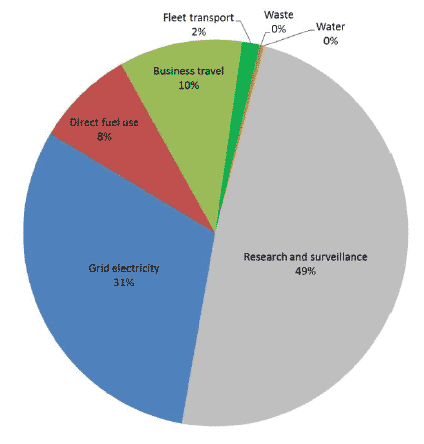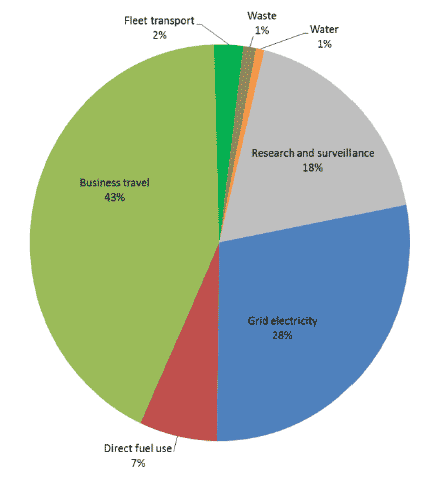Carbon Management Plan 2014
This revised Carbon Management Plan (CMP) sets out the activities that will enable us to reduce our carbon emissions and meet our reduction targets.
1. CMP Background and Remit
The Scottish Government ( SG) signed up to the Carbon Management Programme in 2008 which resulted in the publication of our first Carbon Management Plan ( CMP) in May 2009. In 2012 we signed up to the Carbon Trust's CM Revisited Programme and consequently we have restated our commitment to reducing our estate emissions. This revised CMP sets out the activities that will enable us to reduce our carbon emissions and meet our reduction targets. It resets our baseline carbon emissions to reflect our increased estate boundary and includes a register of projects, both technical and corporate, that will help us deliver our 30% reduction target by 2020.
This CM Plan is a framework for future carbon measurement, monitoring and forecasting which will be subject to regular review. The Plan does not seek to provide updates on previous carbon reduction activities across our estate, since this work is summarised in our published Annual Sustainability Report. However, the CMP aims to support the wider SG environmental policies and will be the main tool for managing our carbon footprint information and reduction measures up to 2020 and beyond.
The ownership of the CMP rests with our People Services Division which is responsible for managing the assets, services and resources used throughout the estate. The CM Revisited Programme started in September 2012 and initially led to the production of a diagnostic report. This report included an action plan that enabled the Carbon Management Team to complete the CMP review by March 2013. The diagnostic report established the overall trend of emissions and our progress to date against the reduction targets.
The findings showed an overall downward trend in our emissions and that we were on track to meet our original 2014 target, had the size of the estate remained at 2007/08 levels. However, it also showed that we are unlikely to achieve our 2020 carbon reduction target based on the current rate of progress and the enlarged estate. The review of the 2009 CMP offered an opportunity for the baseline and interim emission reduction target to be reconsidered. The new CMP reflects the expanded estate and the resultant increase in the SG carbon footprint (estimated at three fold since the original 2007/08 baseline).
What has changed?
In 2008/09, the offices, laboratories and other buildings used by Marine Scotland, Communities Scotland and the Scottish Building Standards Agency became part of the Scottish Government estate. These corporate changes brought an increase in the number of sites within the scope of SG operational responsibilities, and significantly, also included the emissions from Marine Scotland's research and surveillance activities. Consequently, the scope of the SG estate increased from 40 to over 80 sites. As well as changing the scope of SG operational activities, this expansion of the estate significantly increased our carbon emissions threefold. This meant that the projects identified within our initial CMP were no longer adequate to achieve our emission reduction targets.
The table below shows the carbon footprint for each of the seven years and underneath a brief summary of what the footprint includes.
Figure 1.1 How the SG carbon footprint boundary has changed over time.
| Footprint year | Size of footprint (tCO 2e) | Description of carbon footprint boundary |
|---|---|---|
| 2007/08 | 12,788 | Original Carbon Management Plan baseline which included 18 key sites |
| 2008/09 | 13,723 | Subset of 18 sites (energy and waste) and business travel (all SG staff) from the Environmental Performance Annual Report 2008/09 |
| 2009/10 | 41,881 | Revised CMP baseline, including 29 key sites and MS estate, research and surveillance emissions |
| 2010/11 | 38,564 | Same boundary as 2009/10 |
| 2011/12 | 36,417 | Same boundary as 2009/10 |
| 2012/13 | 37,819 | Same boundary as 2009/10 |
| 2013/14 | 34,869 | Same boundary as 2009/10 |
This revised CMP better reflects the challenges faced by the SG's expanded estate by establishing 2009/10 as our new baseline year and identifying additional projects that will allow us to deliver reductions in emissions of:
- 15% by March 2015 and;
- 30% by March 2020.
Technical improvements will be complemented by behaviour change measures as we work with colleagues to ensure the Government's operations are delivered in the most sustainable and efficient way.
The two figures below show the breakdown of the SG baseline (2009/10) carbon footprint by carbon and by cost. This shows that some of the minor sources of carbon such as travel are very important in terms of cost.
Figure 1.2 - Composition of baseline SG footprint by emission source.

Figure 1.3 - Composition of baseline SG footprint by spend

What has been achieved so far?
Over the past three years, the Energy Directorate has provided funds which enabled Facilities Services to spend over £2.3 million on energy efficiency measures that are delivering carbon savings at several sites. During 2012 and 2013, we successfully completed our statutory carbon reporting obligations under the CRC Energy Efficiency Scheme (formerly known as the Carbon Reduction Commitment) and Section 76 of the Climate Change (Scotland) Act 2009. In order to facilitate the transparent, consistent and reliable disclosure of SG environmental information, we moved our annual environmental reports to an online platform called Government On-Line Sustainable Performance Information Exchange ( GOLSPIE).
http://www.scotland.gov.uk/Topics/Government/sustainabilityperformance
What is planned for the future?
As a result of the CMP review, a project register has been developed. This register identifies, quantifies and prioritises those projects that need to be implemented to keep us on track to achieve our targets. Around 127 live projects (54 of which are completed) are now recorded and the progress made against our carbon reduction targets through their delivery is monitored using the Carbon Trust's Carbon Management Project Register ( CMPR) tool. Plans are already underway to work closely with our property and planned maintenance contractor to develop further energy management procedures and projects, and to deliver a staff awareness campaign to promote the CMP and encourage behaviour change across our estate.
The SG was awarded initial certification to the Carbon Trust Standard in July 2012. This award recognised that carbon reductions associated with our energy and vehicle fleet usage had reduced over a three-year period. Due to the continued achievement against Carbon Trust Standard criteria, we will be submitting an application for recertification in 2014. This would include the measurement and assessment of our business travel emissions and fugitive emissions from refrigerants or air conditioning units etc. which are known to be difficult to measure and control.
What is our CMP vision?
We seek to put carbon management at the heart of SG business and achieve sustainable environmental best practice to minimise the impacts of our business activities throughout our estate. This will be achieved through the delivery of our environmental policy and the implementation of the measures outlined in this CMP.
Contact
There is a problem
Thanks for your feedback